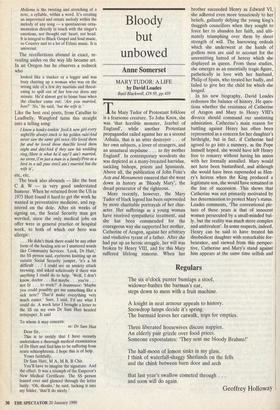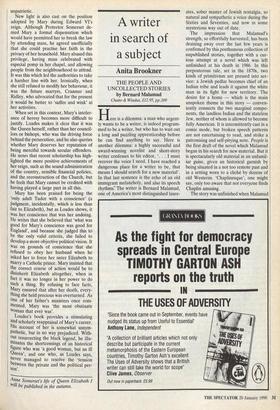Bloody but unbowed
Anne Somerset
MARY TUDOR: A LIFE by David Loades
Basil Blackwell, £19.95, pp.410
The Mary Tudor of Protestant folklore is a fearsome creature. To John Knox, she was 'that horrible monster, Jezebel of England', while another Protestant propagandist railed against her as a second 'Athalia, that is an utter destroyer . . . of her own subjects, a lover of strangers, and an unnatural stepdame . . . to thy mother England'. In contemporary woodcuts she was depicted as a many-breasted harridan, suckling bishops, priests and Spaniards. Above all, the publication of John Foxe's Acts and Monuments ensured that she went down in history as 'Bloody Mary', the dread persecutor of the righteous.
More recently, however, the Mary Tudor of black legend has been superseded by more charitable portrayals of her char- acter. Her sufferings as a young woman have received sympathetic treatment, and she has been commended for the courageous way she supported her mother, Catherine of Aragon, against her arbitrary and vindictive tyrant of a father, After she had put up an heroic struggle, her will was broken by Henry VIII, and for this Mary suffered lifelong remorse. When her brother succeeded Henry as Edward VI, she adhered even more tenaciously to her beliefs, gallantly defying the young king's thuggish councillors when they sought to force her to abandon her faith, and ulti- mately triumphing over them by sheer strength of will. The harrowing ordeals which she underwent at the hands of godless men are said to account for the unremitting hatred of heresy which she displayed as queen. From these studies, she emerges as an essentially tragic figure, pathetically in love with her husband, Philip of Spain, who treated her badly, and failed to give her the child for which she longed.
In his new biography, David Loades redresses the balance of history. He ques- tions whether the resistance of Catherine of Aragon and Mary to Henry VIII's divorce should command our unstinting admiration. Catherine's main reason for battling against Henry has often been represented as a concern for her daughter's birthright, but in fact, if Catherine had agreed to go into a nunnery, as the Pope himself hoped, she would have left Henry free to remarry without having his union with her formally annulled. Mary would not have been bastardised, and although she would have been superseded as Hen- ry's heiress when the King produced a legitimate son, she would have remained in the line of succession. This shows that Catherine was not primarily motivated by her determination to protect Mary's status. Loades comments, The conventional pic- ture of these years is that of innocent women persecuted by a small-minded bul- ly, but the reality was much more complex and ambivalent'. In some respects, indeed, Henry can be said to have treated his disobedient daughter with remarkable for- bearance, and viewed from this perspec- tive, Catherine and Mary's stand against him appears at the same time selfish and unpatriotic.
New light is also cast on the position adopted by Mary during Edward VI's reign. Although Protector Somerset de- nied Mary a formal dispensation which would have permitted her to break the law by attending mass, he agreed unofficially that she could practise her faith in the privacy of her household. Mary abused this privilege, having mass celebrated with especial pomp in her chapel, and allowing people from the neighbourhood to attend. It was this which led the authorities to take a harsher line with her. Ironically, when she still refused to modify her behaviour, it was the future martyrs, Cranmer and Ridley, who advocated that for the present it would be better to 'suffer and wink' at her activities.
When set in this context, Mary's intoler- ance of heresy becomes more difficult to justify. Loades makes it clear that it was the Queen herself, rather than her council- lors or bishops, who was the driving force behind the persecution, and he also queries whether Mary deserves her reputation of being merciful towards secular offenders. He notes that recent scholarship has high- lighted the more positive achievements of her reign, such as the sound administration of the country, sensible financial policies, and the reconstruction of the Church, but he feels that Mary cannot be credited with having played a large part in all this.
Mary has been praised for being the `only adult Tudor with a conscience' (a Judgment, incidentally, which is less than fair to Elizabeth), but as Loades shows, it was her conscience that was her undoing. He writes that she believed that 'what was good for Mary's conscience was good for England', and because she judged this to be the only valid criteria, she failed to develop a more objective political vision. It was on grounds of conscience that she refused to obey her husband when he asked her to force her sister Elizabeth to marry a Catholic prince. Mary insisted that the correct course of action would be to disinherit Elizabeth altogether, when in fact it was no longer in her power to do such a thing. By refusing to face facts, Mary ensured that after her death, every- thing she held precious was overturned. As one of her father's ministers once com- mented, Mary was `the most obstinate Woman that ever was'.
Loades's book. provides a stimulating and scholarly reappraisal of Mary's career. His account of her is somewhat unsym- pathetic, but in no way prejudiced. With- out resurrecting the black legend, he illu- minates the shortcomings of an historical figure who was 'a good woman, but an ill Queen', and one who, as Loades says, never managed to resolve the `tension between the private and the political per- son,.
Anne Somerset's life of Queen Elizabeth I will be published in the autumn.



















































 Previous page
Previous page